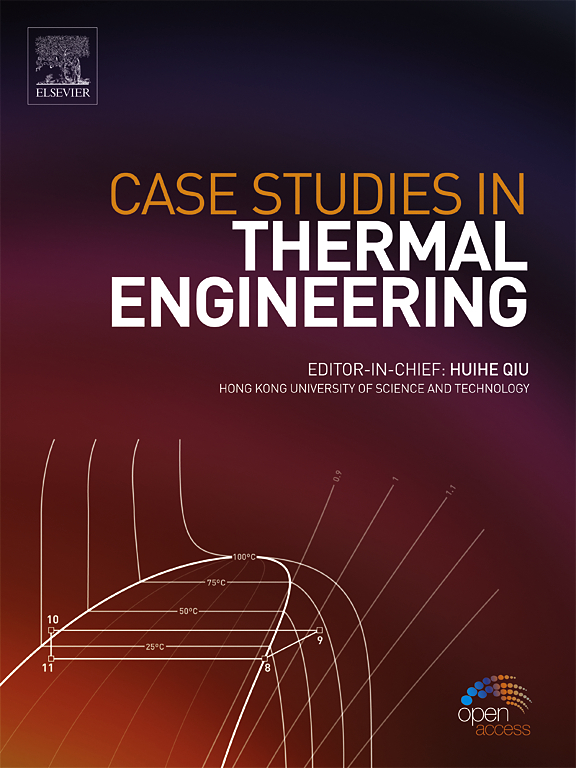Analysis and optimization of a high-speed generator's cooling structure based on Taguchi method
IF 6.4
2区 工程技术
Q1 THERMODYNAMICS
引用次数: 0
Abstract
To increase the power density of the original generator, it is desired to boost the generator's power to 1.2 times its original capacity. However, the cooling structure of the original generator cannot meet the heat dissipation requirements of the upgraded power level. It necessitates a redesign of the cooling structure. For the stator, water pipes through the stator core yoke are added; for the rotor, a novel rotor cooling structure is designed. The structure includes the groove bottom vent beneath the rotor excitation winding and the radial auxiliary grooves on the sides. The airflow passes through the groove bottom vent and then follows the radial auxiliary grooves until it reaches the air gap. It can efficiently remove the heat from the rotor excitation winding. The results of the new scheme are discussed. When comparing the new scheme with the original one, the highest temperature of the stator winding decreases by 20.6k, while the one of the rotor excitation winding does by 23.7K. To further improve the cooling structure, the Taguchi method is employed. The optimization variables include the area of the stator back vent, the number of radial auxiliary grooves, and the height of the groove bottom vent. The optimization objectives are the highest temperature of the stator winding, the highest temperature of the rotor excitation winding, the air friction loss, and the inlet-outlet static pressure difference. By analyzing the variance and range of the results, the improved scheme is obtained. Comparing the improved scheme with the new one, the temperature distribution difference between them is negligible. The improved scheme reduces the air frictional loss by 10.7 %, but increases the inlet-outlet static pressure difference by 8.0 %.
基于田口方法的高速发电机冷却结构分析与优化
为了提高原有发电机的功率密度,希望将发电机的功率提升至原来的 1.2 倍。然而,原有发电机的冷却结构无法满足功率升级后的散热要求。这就需要重新设计冷却结构。在定子方面,增加了穿过定子铁芯轭的水管;在转子方面,设计了新颖的转子冷却结构。该结构包括转子励磁绕组下方的槽底通风口和两侧的径向辅助槽。气流穿过槽底通风口,然后沿着径向辅助槽到达气隙。它能有效地去除转子励磁绕组的热量。本文讨论了新方案的结果。新方案与原方案相比,定子绕组的最高温度降低了 20.6 千帕,而转子励磁绕组的最高温度降低了 23.7 千帕。为了进一步改进冷却结构,采用了田口方法。优化变量包括定子后通风口的面积、径向辅助槽的数量和槽底通风口的高度。优化目标是定子绕组的最高温度、转子励磁绕组的最高温度、空气摩擦损耗和入口-出口静压差。通过分析结果的方差和范围,得出了改进方案。将改进方案与新方案进行比较,两者之间的温度分布差异可以忽略不计。改进方案减少了 10.7 % 的空气摩擦损耗,但增加了 8.0 % 的入口-出口静压差。
本文章由计算机程序翻译,如有差异,请以英文原文为准。
求助全文
约1分钟内获得全文
求助全文
来源期刊

Case Studies in Thermal Engineering
Chemical Engineering-Fluid Flow and Transfer Processes
CiteScore
8.60
自引率
11.80%
发文量
812
审稿时长
76 days
期刊介绍:
Case Studies in Thermal Engineering provides a forum for the rapid publication of short, structured Case Studies in Thermal Engineering and related Short Communications. It provides an essential compendium of case studies for researchers and practitioners in the field of thermal engineering and others who are interested in aspects of thermal engineering cases that could affect other engineering processes. The journal not only publishes new and novel case studies, but also provides a forum for the publication of high quality descriptions of classic thermal engineering problems. The scope of the journal includes case studies of thermal engineering problems in components, devices and systems using existing experimental and numerical techniques in the areas of mechanical, aerospace, chemical, medical, thermal management for electronics, heat exchangers, regeneration, solar thermal energy, thermal storage, building energy conservation, and power generation. Case studies of thermal problems in other areas will also be considered.
 求助内容:
求助内容: 应助结果提醒方式:
应助结果提醒方式:


